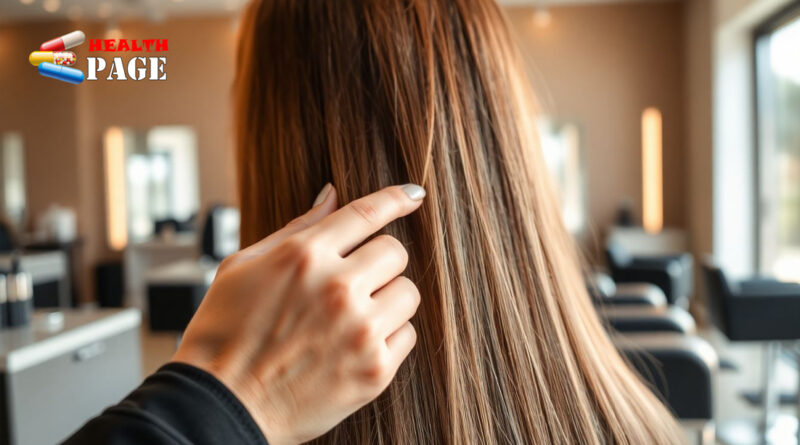Effective Split End Treatment: The Ultimate Guide to Healthy, Damage-Free Hair
Split ends are a common problem for many people. They make hair look dull, frizzy, and unhealthy. If left untreated, split ends can travel up the strand and cause more damage. Addressing split ends early is the key to keeping your hair strong and shiny. In this guide, you’ll learn what causes split ends and how to treat them effectively. We’ll cover quick fixes, home remedies, and professional options to give your hair the care it needs. In this article you will know about split end treatment.
Understanding Split Ends: Causes and Types
What Are Split Ends?
Split ends happen when the protective outer layer of hair gets damaged. This causes the hair fiber to fray at the tip, splitting into two or more parts. Imagine a rope unraveling at the ends—that’s similar to what happens with split ends. Some splits are simple, just one line, while others branch out into multiple splits, making hair look frizzy and untamed.
Common Causes of Split Ends
- Heat styling tools: Straighteners and curling irons dry out hair, leading to cracks and splits.
- Chemical treatments: Bleaching, coloring, or relaxing weakens hair fibers.
- Mechanical damage: Brushing or combing too roughly can cause stress on hair ends.
- Environmental factors: Sun, pollution, and cold weather strip moisture and weaken hair.
- Poor hair care habits: Using harsh shampoos, too-warm water, or skipping conditioner damages hair over time.
- Nutritional deficiencies: Not eating enough vitamins like A, C, E, or Biotin can make hair more fragile.
How to Identify Split Ends
Visual cues include frayed or uneven tips, rough texture, and hair that appears more damaged on the ends. If you notice split ends, don’t wait too long to address them. Sometimes, hair feels rough or sticky at the tips, which signals trouble. For a thorough check, visit a hairstylist for professional advice.
Preventative Measures to Minimize Split Ends
Proper Hair Care Routine
- Use gentle, sulfate-free shampoos that clean without stripping natural oils.
- Always condition after washing to lock in moisture.
- Incorporate nourishing hair masks once a week to reinforce strands.
Heat and Chemical Damage Control
- Limit heat styling to special occasions.
- Always use a heat protectant spray before styling.
- Avoid frequent perms, relaxers, or bleachings that weaken hair structure.
Healthy Lifestyle and Nutrition
- Eat a balanced diet rich in vitamins A, C, E, and Biotin.
- Drink plenty of water to keep hair hydrated.
- Manage stress through exercise and relaxation techniques.
Daily Hair Care Tips
- Use a wide-tooth comb and be gentle.
- Avoid vigorous brushing when hair is wet.
- Opt for protective hairstyles that prevent tugging and pulling.
Effective Treatments for Split Ends

Trimming: The Immediate Solution
Getting regular trims is the fastest way to remove split ends. A professional trim every 6 to 8 weeks prevents damage from traveling up the hair shaft. DIY trims are fine if done carefully—just snip off a little at a time. Remember, trimming isn’t about losing length, but keeping hair healthy.
Deep Conditioning and Hair Masks
Deep conditioners and hair masks rebuild damaged strands. Look for ingredients like keratin, shea butter, or coconut oil that nourish and strengthen hair. Apply masks from mid-length to ends, leaving them on for the recommended time. This makes hair softer, smoother, and less prone to splits.
At-Home Remedies for Split End Repair
Natural oils are your friends. Use argan, castor, or olive oil to moisturize hair ends. Massage warm oil into tips, cover with a towel, and leave it for 30 minutes. Do this weekly for better results. DIY masks like honey and yogurt can add moisture, but remember, home remedies can’t fully fix existing splits—they prevent future ones.
Salon Treatments for Split Ends
Professionals offer advanced repairs like keratin treatments or bond-building infusions. These treatments restore strength and smoothness, making split ends less visible temporarily. Sometimes, a special sealing treatment can help close the cuticle and improve your hair’s appearance.
Split End Preventive Products
Serums and leave-in conditioners with nourishing oils can protect hair ends. Look for lightweight formulas that smooth, hydrate, and seal the cuticle. Using these regularly keeps your ends looking healthy and reduces the chance of new splits forming.
Long-Term Hair Care Strategies
Regular Hair Trims and Maintenance
Make trimming a routine every 6-8 weeks. Keep a close eye on your ends and trim whenever you see signs of damage. Early trims save you from more severe split-end problems later on.
Incorporating Repair Treatments
Use salon-recommended leave-in serums or oils and deep condition monthly. These products seal moisture and rebuild weakened strands, making your hair stronger over time.
Lifestyle Adjustments
Protect hair from sun damage by wearing hats or using UV protectant sprays. Always use heat protectants before styling and avoid over-processing chemical treatments. Your hair’s health depends on steady, gentle care and avoiding unnecessary stress.
Conclusion
Split ends are a common issue but manageable with the right steps. Regular trims, nourishing treatments, and smart habits will keep your hair looking its best. Remember, prevention is better than cure—use protective styles, limit heat and chemicals, and eat well. Your hair deserves attention, and with patience, you can maintain strong, healthy, split-end-free locks.
Taking good care now means fewer trims later and more time loving your hair. Start small—trim regularly, nourish deeply, and protect daily. Healthy hair isn’t a dream—it’s a routine.



Pingback: Top 12 Anti-Aging Ingredients for Radiant, Healthy Skin